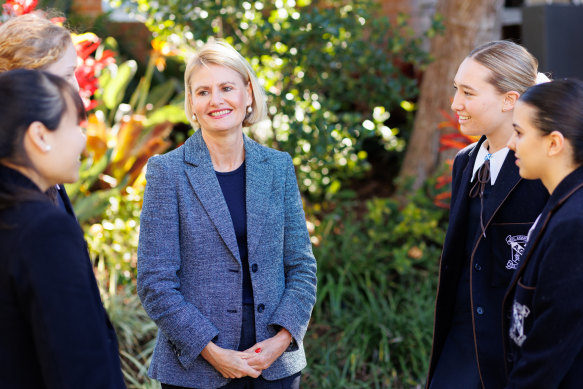- Perspective
- National
- Queensland
- Education
This girls’ school is Brisbane’s best, according to epic ATAR data project
An Anglican girls’ school in the western suburbs arguably achieved Brisbane’s best year 12 results last year – but bringing you this information was no small feat.
While NSW and Victoria release individual school ATAR data, Queensland stopped publishing its report of results in 2021, when the state switched from OPs to ATARs.
Private tutoring company Art of Smart has since embarked on a mammoth task, recruiting a data specialist to scrape publicly available data for every Greater Brisbane school’s 2023 ATAR results. This data is internally verified, and analysed by a statistician.

St Aidan’s principal Toni Riordan says when girls leave the non-selective Brisbane school, they feel confident to lead.
Art of Smart compared each school’s cohort to the QTAC ATAR distribution report, to work out how the school performed compared with the state’s average.
The top two schools were girls’ schools, followed by Brisbane’s most expensive boys’ school, and then a prestigious public school with selective entry.
St Aidan’s Anglican Girls’ School, in Corinda, did 251 per cent better than the state average, followed by Brisbane Girls Grammar, Brisbane Grammar School and Brisbane State High.
St Aidan’s principal Toni Riordan said she was proud of every student who graduated from the non-selective school in 2023, and her teaching staff, but said ATAR results were only one indicator of hard work.
On the question of girls’ schools impressive performance, Riordan said research consistently demonstrated their benefits.
She said that included “a learning environment free from gender stereotyping, where girls outperform girls in co-educational schools across academic, social and emotional measures”.
“Our students’ strong performance in traditional STEM subjects are a result of the safe and supported space encountered at St Aidan’s and the deep sense of self-belief and confidence, which is successfully instilled in all our students,” she said.
While the top spots were dominated by private schools, Mansfield and The Gap state high schools also made the top 25.
The school with the highest proportion of students achieving above an ATAR 99 was Brisbane State High School, with 17 per cent.
Anglican schools were on average the highest performers, followed by public, private (defined as Lutheran, Presbyterian and non-denominational), and Catholic.
The company also found the “top cost-of-living schools” by looking at mortgage and renting costs, tuition fees, and average living expenses within five kilometres of each school, matched against school performance. Ipswich Grammar came out on top, followed by Ormiston College, in Redland City.
Art of Smart’s data includes disclaimers.
Schools with a single asterisk did not report the proportion of the cohort achieving an ATAR. A double asterisk indicates the “proportion of students achieving an ATAR was lower than similar schools, which may elevate the mean scores reported here”.
If a group of high-performing students is chosen to represent the entire school’s graduating cohort, it can lead to inflated results – so schools were assessed based on location, a socio-economic index and historical data on ATAR cohort sizes to find the expected percentage that should graduate with an ATAR.
Not every school publishes data publicly, so they were not included, and students don’t have to share results with their school.
This is the issue with the Queensland government’s refusal to continue publishing comprehensive, transparent year 12 data.
Data available in southern states allows our colleagues at The Sydney Morning Herald and The Age to celebrate wins, such as the school that rocketed up the HSC rankings by 200 places, explain in detail how boys schools are closing the gap on girls as single-sex schools outperform co-ed, and the performance of private versus public schools.
When Queensland results are released in December, our government provides a media release with overall statewide figures, such as how many students graduated year 12, and how many received QCEs and ATARs in total, which illuminates very little.
Last year, then-education minister Grace Grace told this masthead ATARs were not designed as a measure of school performance, but were calculated by QTAC to support tertiary entrance, pointing out individual school results, like QCE attainment rates, were available through annual reports.
But annual reports do not include ATAR results. I know, because I’ve manually trawled the annual reports of every Brisbane state primary and high school to produce a series of stories, including searchable tables, on class sizes, absences and holidays, and the tiny school that is still shrinking.
Some argue it is unfair to publish league tables because cashed-up private schools cannot be compared with public schools where students come from disadvantaged backgrounds.
But I believe you’re smart enough to understand socio-economic context, and know the year 12 results of one cohort should not be the only factor in schooling decisions, while transparency gives families and principals ammunition to fight for better resourcing.